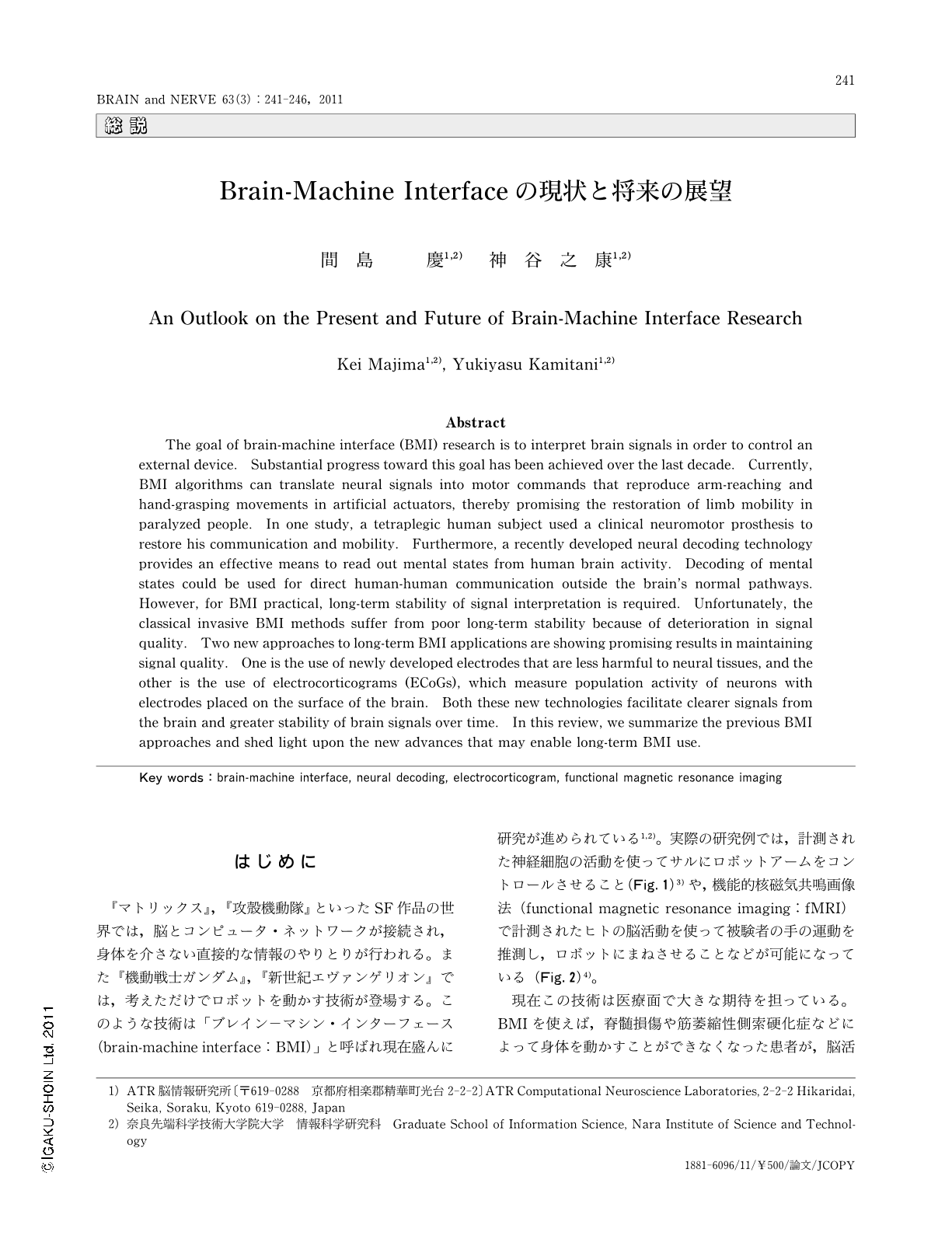Japanese
English
- 有料閲覧
- Abstract 文献概要
- 1ページ目 Look Inside
- 参考文献 Reference
はじめに
『マトリックス』,『攻殻機動隊』といったSF作品の世界では,脳とコンピュータ・ネットワークが接続され,身体を介さない直接的な情報のやりとりが行われる。また『機動戦士ガンダム』,『新世紀エヴァンゲリオン』では,考えただけでロボットを動かす技術が登場する。このような技術は「ブレイン-マシン・インターフェース(brain-machine interface:BMI)」と呼ばれ現在盛んに研究が進められている1,2)。実際の研究例では,計測された神経細胞の活動を使ってサルにロボットアームをコントロールさせること(Fig.1)3)や,機能的核磁気共鳴画像法(functional magnetic resonance imaging:fMRI)で計測されたヒトの脳活動を使って被験者の手の運動を推測し,ロボットにまねさせることなどが可能になっている(Fig.2)4)。
現在この技術は医療面で大きな期待を担っている。BMIを使えば,脊髄損傷や筋萎縮性側索硬化症などによって身体を動かすことができなくなった患者が,脳活動から直接義肢を操作したり,意思を伝達したりすることができるようになるだろう。
応用は医療面のみにとどまらない。BMIは健常者に対しても通常の経路を介さないダイレクトな情報伝達を可能にするため,他人に伝えることが難しい主観的なイメージなどをやりとりすることも将来可能になるかもしれない。
BMIの分類法には,情報の流れる向きによる分け方(出力型・入力型)と,計測手法による分け方(侵襲型・非侵襲型)がある。
出力型BMIは,脳から計測された信号を利用するBMIである。計測された脳信号によってロボットや画面上のカーソルなどの外部装置を制御する,あるいは知覚内容や意思を読み取るなど,脳から情報を読み出すBMIがこれにあたる。入力型BMIは,脳を刺激し信号を直接送り込むBMIである。脳を刺激することで感覚を生起させるBMIや,機械からのフィードバック信号を脳に直接伝達するBMIがこれに含まれる。
もう1つの分類法は計測手法に基づく分け方である。侵襲型BMIは脳内,脳表面に電極を設置し,計測された電気信号を利用する方法である。非侵襲型BMIは,脳波(electroencephalogram:EEG),近赤外線分光法(near-infrared spectroscopy:NIRS),fMRIなどを用いて,脳の組織を傷つけずに脳活動を計測し,利用する方法である。侵襲型は,高精度な信号が計測できるが,感染症などのリスクがある。一方,非侵襲型は,安全性が高い反面,高精度な信号を得るためには,大がかりな計測装置が必要となる。
本稿では出力型BMI,その要素技術である脳情報デコーディングの具体的な研究例を挙げ解説する。そしてBMIが長期間の使用に耐え得るかという安定性の問題とそれに対するアプローチを紹介する。
Abstract
The goal of brain-machine interface (BMI) research is to interpret brain signals in order to control an external device. Substantial progress toward this goal has been achieved over the last decade. Currently,BMI algorithms can translate neural signals into motor commands that reproduce arm-reaching and hand-grasping movements in artificial actuators,thereby promising the restoration of limb mobility in paralyzed people. In one study,a tetraplegic human subject used a clinical neuromotor prosthesis to restore his communication and mobility. Furthermore,a recently developed neural decoding technology provides an effective means to read out mental states from human brain activity. Decoding of mental states could be used for direct human-human communication outside the brain's normal pathways. However,for BMI practical,long-term stability of signal interpretation is required. Unfortunately,the classical invasive BMI methods suffer from poor long-term stability because of deterioration in signal quality. Two new approaches to long-term BMI applications are showing promising results in maintaining signal quality. One is the use of newly developed electrodes that are less harmful to neural tissues,and the other is the use of electrocorticograms (ECoGs),which measure population activity of neurons with electrodes placed on the surface of the brain. Both these new technologies facilitate clearer signals from the brain and greater stability of brain signals over time. In this review,we summarize the previous BMI approaches and shed light upon the new advances that may enable long-term BMI use.

Copyright © 2011, Igaku-Shoin Ltd. All rights reserved.


